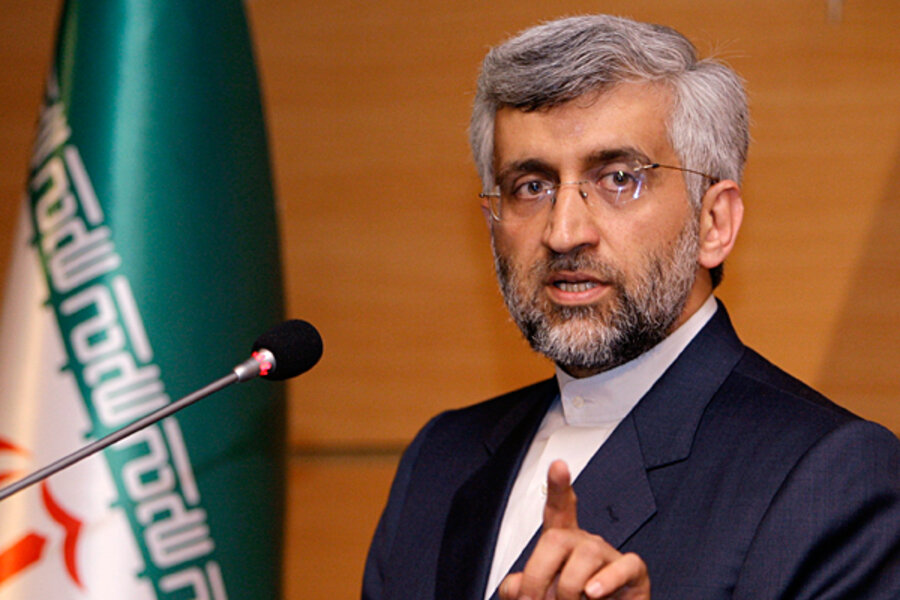Iran nuclear talks: What happened to the nuclear fuel-swap deal?
Loading...
| Istanbul, Turkey
One issue was expected to be a centerpiece of Iran’s nuclear talks with world powers in Istanbul last weekend: a fuel-swap deal billed as a critical “confidence-building” measure.
But the two days of talks ended in stalemate. Negotiators from the so-called P5+1 nations – US, Russia, China, Britain, France, and Germany – could not move beyond Iranian preconditions that the group recognize Iran’s “right” to enrich uranium and agree to drop sanctions before substantive talks could begin.
So what happened to the nuclear fuel-swap deal?
And how did the P5+1 revise the deal first put to Iran – and rejected by it – in October 2009? In that proposal, Iran would have exported the bulk of its homemade low-enriched uranium (LEU) for further refinement in Russia, then made into fuel rods in France, for a small research reactor in Tehran.
The short answer is that the deal was barely discussed. But the “upgraded” version of the deal, which was laid out for the Iranians at the Istanbul talks, requires that Iran export a “greatly increased quantity,” according to Western diplomats engaged in the talks.
The long answer depends on whom you ask.
After the talks ended Saturday, Iran’s chief negotiator Saeed Jalili made no mention of the fuel-swap proposal in lengthy comments to journalists until asked specifically about it.
Speaking in the future tense, Mr. Jalili said a fuel deal “could be one of the most important areas for cooperation,” and that during talks in Istanbul on this point “we very openly put forward what we want.”
After the Istanbul sessions ended without progress, and while most press coverage cited Iran’s preconditions for the breakdown, Jalili’s deputy on Iran’s Supreme National Security Council talked further on the fuel swap.
A story by Iran’s state-run PressTV, titled “Iran ready to talk fuel swap,” quotes Ali Baqeri as saying that Iran received the P5+1 proposal, but “we stressed that Iran does not need fuel swap and what prompts Iran to negotiate on the issue is cooperation and not necessity.”
Iranian officials say the decades-old reactor in Tehran, which is used to make medical isotopes, is running out of fuel. Fabricating the material is a complex process only undertaken by a few countries anymore, a process that – as hopes for a deal have remained elusive – Iran has claimed it will master.
“These talks could continue in the future and there is no obstacle, but the P5+1 should be given an opportunity to reach a conclusion for cooperation,” Baqeri said.
Iranian officials have said before they would not give away more in a fuel-swap deal, as required by the one spelled out in Istanbul. Since the first offer, and in defiance of UN Security Council resolutions, Iran has continued to enrich uranium to 3.5 percent purity.
Iran also began enriching to 19.75 percent last February – the level needed to make its own fuel for the Tehran reactor, but also one step closer to being capable of making a nuclear weapon.
So what did that “upgraded” fuel offer entail?
On Friday night, the first night of Istanbul talks, Iranian negotiators seemed to “waver” in their insistence about previous preconditions, which paved the way for a Saturday morning meeting between the US, Russia, and France with Iran “to set out what we meant [by] updating” the fuel-swap deal, according to a senior European diplomat involved in the talks.
“Whereas 15 months ago we saw the removal of 1,200 kilograms of [LEU] from Iran as a very considerable confidence building measure, its value had sharply fallen in the intermediate period because [now] they’ve got a whole lot more [LEU],” said the European diplomat, who spoke with several journalists after the talks on the condition of anonymity.
“Therefore on our side, we wanted [Iran to export] a greatly increased quantity. The number changes over time. The important number is … not the number we remove, it’s what’s left behind,” the diplomat said. “What we wanted to do is to leave behind in Iran roughly what would have been left behind in the original [October 2009] proposal – that is to say, it is a level which is some way short of what you need to make a weapon.”
The new P5+1 proposal would also include removal of all the 19.75 percent enriched material. “That had to go as well. And any deal would have to involve agreement by Iran that they would cease enriching to that level, too,” said the diplomat.
Iranian officials have stated in the past that they would not accept a deal that requires them to ship out even more nuclear material in exchange for fuel. But Western diplomats say they never got far enough with Iran to test that position.
“There wasn’t, on either the [fuel swap] proposals or the transparency measures which were suggested, a specific or detailed reaction [from Iran],” said a senior US official at the talks. “And in fairness, we put them on the table [and] said we’re prepared to talk about them in more detail, and talk about them seriously, but … the conversation then shifted essentially to, ‘What’s the basis for having those kind of conversations?' "





